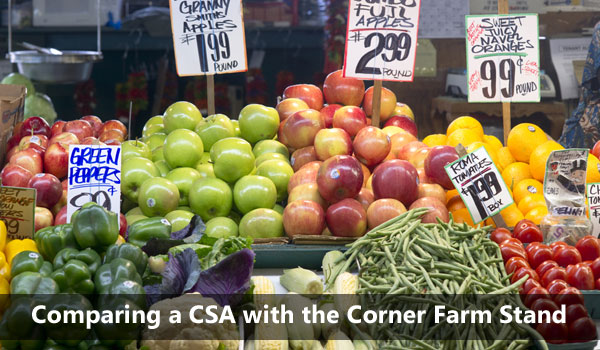For years, we bought our produce at the big chain super store with all of our other shopping.
Then one summer, my husband’s work offered a farm share, also known as a CSA, community supported agriculture. We loved the idea of supporting a local farm and getting better quality food, but he worked too far from home for that offer to work. Inspired, we searched a community farmer’s market for summer farm shares. We choose one that delivered to our home instead of us having to make a scheduled pick up each week,. That was a huge plus with my son about to be born. We did the farm share for two summers.
Benefits of the farm share:
- Fresh, local, organic produce.
- Support a local farm.
- Option to buy other products. The farm we paired with offered eggs, bread, soap, alpaca knitting, and meats.
- Try new foods. Turns out I love kale chips, and the whole family liked baked acorn squash.
- Loved the farmer. She shared recipes with us using what she brought each week, and one time even brought a newborn goat for my daughter to play with in the yard!
- Option to visit the farm.
Negatives of the farm share:
- No choices. We thought the CSA would give us most of the items we ate from our parents’ backyard gardens growing up. But, the farm share gave us what they had, which was often not what we wanted.
- Expensive. It cost us $350 for a half share spread over mid-May to mid-October. If this had covered all our needs, it would have been a bargain, but we had to spend at least $20 on other produce every week.
- Plan around the drop off time. This wasn’t a huge inconvenience, but did limit us sometimes.
- Farm too far away. With two children under three, we only managed to visit the farm once over the two summers.
- Too much food. Even with a half share, we gave food away so it wouldn’t spoil. Other times, we gave away the food we didn’t like, such as onions or rhubarb.
After two summers, we decided to try something new. We shopped the small farm stand around the corner from our house.
Benefits of the farm stand:
- Saved money. We bought 100% of our produce from the farm stand between opening day in May through closing the week of Halloween. I saved our receipts to compare. We spent about $700 over 25 weeks, averaging just $28 a week. I was shocked that we went spent so little on so much food!
- Choice. The farm stand had everything we wanted. Native items were marked, so I could choose to buy local berries, corn, green beans, cucumbers, and tomatoes — all the items we missed with the CSA. Items such as citrus and bananas that could not be grown locally were also available. Far more local and organic choices were available than the big supermarket.
- All fresh produce for the duration of the warm weather.
- Supported a local business, and got good service as a returning costumer.
- Better quality produce than the big grocery store.
- Walking distance from our house. Early in the season, I would walk the kids over, one in the stroller and one on foot. Sadly, I had to stop because once we added watermelon and ears of corn, the volume of food we bought wouldn’t fit in the basket under the stroller!
Negatives of the farm stand:
- Extra errand. Going to the farm stand was one more errand to run each week. More than once I considered just buying produce at the big supermarket while we were there, but resisted.
- A lot of work to bring the kids. Even though the kids enjoyed going, I couldn’t let them roam the farm stand. It was on a very busy street and my youngest would have sampled everything.
- Fruit flies. We got fruit flies a couple times, but were able to get them under control quickly.
After this year’s experiment, we will stick with the farm stand for a while. Maybe when my kids are grown and eat more, and if I learn to can, we will try a CSA again.
How have you gotten your summer produce? Do you belong to a CSA or shop at a small local establishment?

